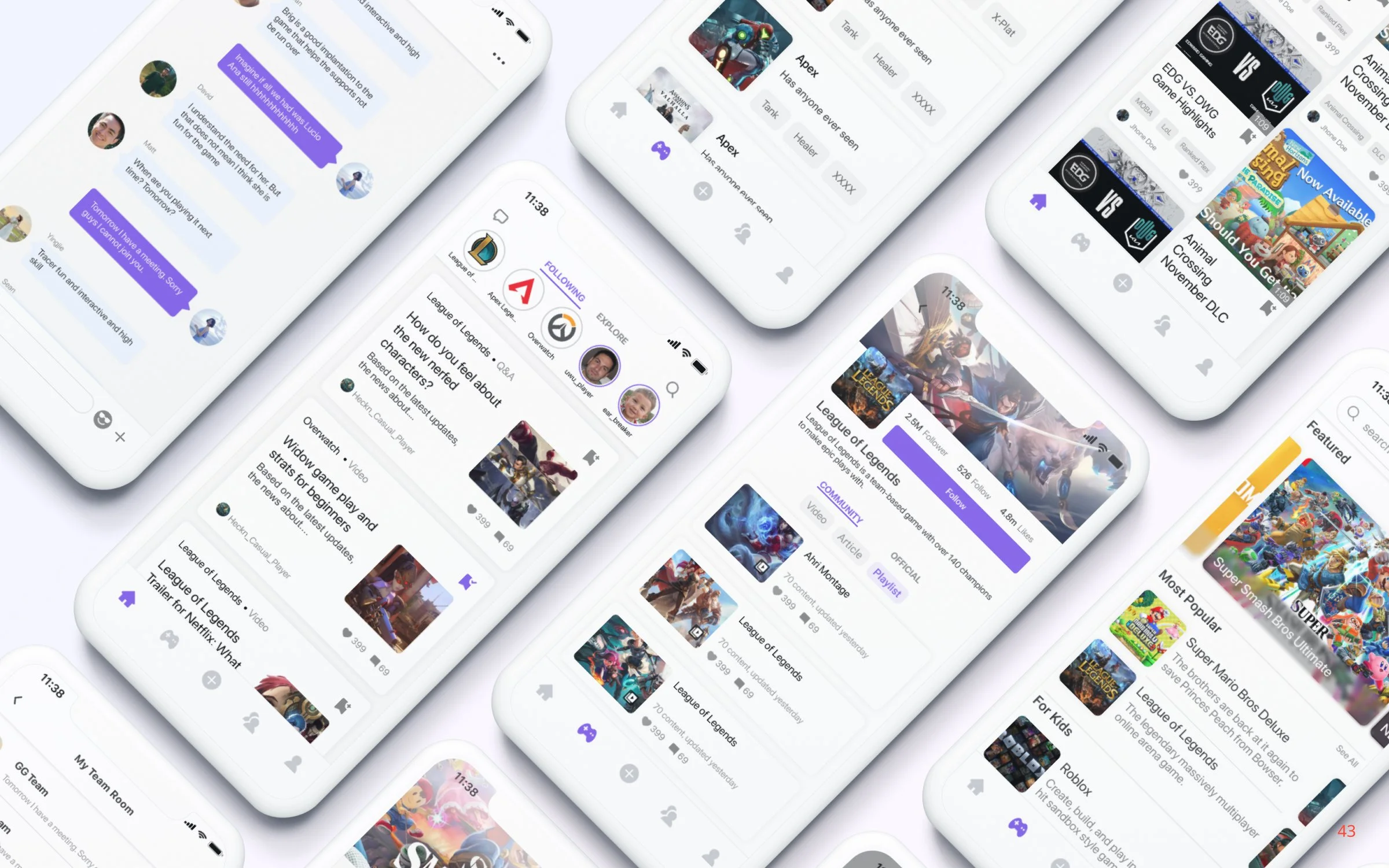
Good Game
An application for promoting cooperative play among gamers.
\
What Did We Design?
Good Game is an application prototype that my team and I designed for our graduate course. It serves two primary functions:
Matches gamers with compatible personalities and abilities for online play
Pools gamer-created content into a logical, user-friendly organization scheme.
Tell Me More…
Our team chose to focus on our mutual interest in video games. Those of us who grew up in the nineties and early aughts have similar, frustrating memories of getting stuck somewhere in-game; in those days you either knew a friend who could get you past the obstacle, or you beat your head against a wall trying to figure it out.
Fast forward to 2022 and there is exponentially more help for gamers available online. Too much, in fact, as we've replaced the barest trickle of information with a fire hose. This problem - information overload - was the original impetus for our project.
Our early research uncovered another issue - that of how disagreeable the online gaming experience can be. Many gamers (and particularly those deemed ‘unconventional’) are regularly harassed when playing in online cooperative mode. This tarnishes an otherwise enjoyable experience.
Enter "Good Game", an application prototype which provides both a centralized forum for game-related content and a team-matching system for online play. These features are intended to enhance one another; players in need of teammates can suss out one another through their content, while the content itself serves to draw additional users into the matchmaking pool.
We recognize that no single application can shift gaming culture overnight, but we hope that “Good Game” can offer a healthy alternative to the current system.
About the Project
Goal
Create a prototype from scratch that addresses the needs of the gaming community .
Timeline
10 weeks
Team Members
Matt Nguyen, Sean Willard, Ruoxuan Pan, Yingjie Li, David Kerr
My Role
Graaduate UX Designer/Researcher with the University of Texas iSchool
Advisor
A. Fleming Seay
My Responsibilities
Conducted user Interviews
Wrote user survey
Sketched/Designed User Personal Page (section of app)
Prototyped User Personal Page
Organized User Tests (wrote moderator script, wrote task list, conducted in person test sessions, uploaded test to usertest.com)
Primary Objectives
Sort/filter video game content (articles, videos, walkthroughs, etc…) in a way that makes intuitive sense
Provide a venue which encourages players to match and interact with one another in a positive way

Our Process
-

1. Ideation
-

2. Competitive Analysis
-

3. User Input
-

4. Concept Revision
-

5. Group Consensus
-

6. Concept Sketching
-

7. Wireframing
-

8. Prototyping
-

9. User Testing
-

10. Presentation
From modest beginnings…
My Role: User Profile Page
Each team member focused on designing one section of the application; mine was the user profile page. My goal was to incorporate three primary functions:
Showcasing User Interests/Skills (for match-making)
Consolidating User-Created Content
Consolidating User-Bookmarked Content
The Evolution of the Profile Page
Final Product
-

Content Sorting
Users search for content via game pages (not content-creators)
Each game page combines functionality for videos, articles, and discussion forums
-

Team Matching
Users input basic info (e.g. game, skill level, play style)
Users presented with suggested matches
Users can message potential and current matches
-

User Presence
Users can showcase abilities and bookmark content
Allows users to suss out one another for team matching
Main Takeaway
-

Good Game addresses a desire in the gaming community for less toxic online play.
-

Users responded well to our architecture, and navigated through the prototype with ease
Tell Me More…
How did the “Good Game” prototype perform against our initial goals? I believe that the results were mixed, but all along the right trajectory.
First, the success; “Good Game” tested well with users, who were able to find what they were looking for within our architecture. This gives me confidence that the app will still make intuitive sense even if we eventually add a LOT more content. That’s good news for our concept; remember that we were originally trying to solve the problem of gamers finding what they need.
Second, the room for improvement; I would have loved to spend more time on the team-matching function. One of the gamers I interviewed early on (a 30-something female) told a wrenching anecdote of being harassed by male gamers to the point where she tries to obscure her actual voice during online play. I don’t think that our current matching function is nearly sophisticated enough to help address that issue - the questions we’re information wer’e asking users to provide is just too basic. That said, I think we’re on the right track. I suspect that if users were given the opportunity to offer feedback as they play, ongoing algorithmic refinement might better ‘pool’ those with similar outlooks and goals.
Finally, I still believe that the core concept of the application is a good one. As one user said: “I think that gaming can be a really intimidating world to enter, and your app helps make it accessible”.











